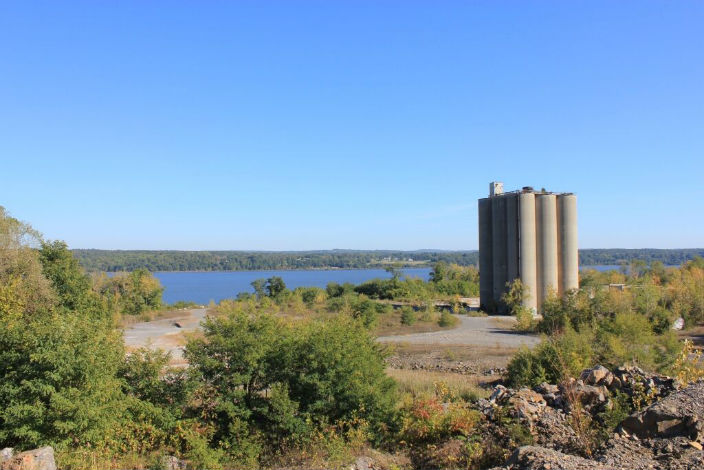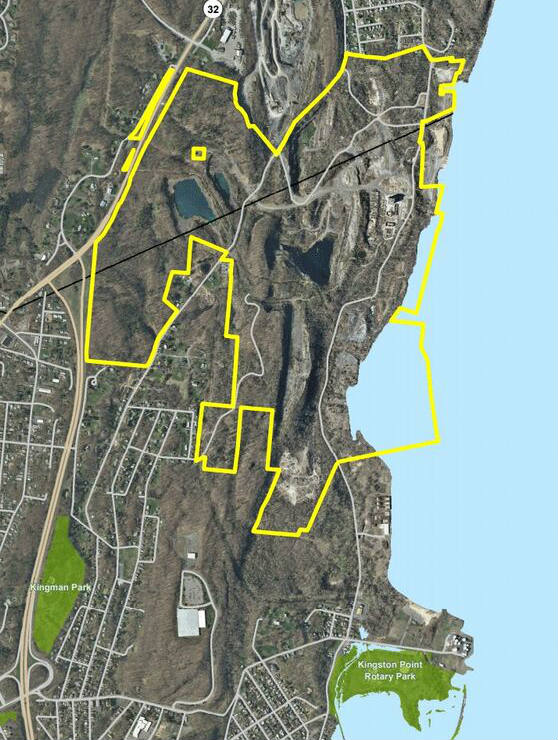
(Scenic Hudson)
Scenic Hudson wants to buy the 508-acre site of the Kingston Landing development project on the former Tilcon property along the Hudson River in the City of Kingston and Town of Ulster. In a release late last Friday, the land conservation and environmental advocacy organization said it was studying transforming “the property into a public asset that would strengthen local communities’ relationship with the river, enhance tourism-based economies and complement ongoing projects to provide new recreational opportunities.”
Proposed in its earliest form in 2002. the Kingston Landing project, whose environmental impact statement was completed a decade ago, would have essentially created a new Kingston-Ulster neighborhood with 1682 dwelling units and about two acres of commercial space in five development phases. It was widely touted at the time as a model for “traditional neighborhood development.” The first phase would have included a waterfront promenade, 388 residential units and 21,000 square feet of commercial space.

AVR, the regional developer with a large portfolio of properties in the Northeast region, never moved forward with the project. AVR vice-president Tom Perna, active in the Kingston Landing project, was quoted late last week as being excited by Scenic Hudson’s interest in the property. Scenic Hudson said it had secured the rights to buy it.
The Tilcon property contains both elements of a scarred extractive industrial landscape and areas of great natural beauty. According to Scenic Hudson, its features include 260 acres of undisturbed woodlands, a mile of riverfront, 37 acres of wetlands and other natural features. As the project proceeds, Scenic Hudson president Ned Sullivan said, his organization would be reaching out to foundations and other potential partners for funding.
With Scenic Hudson at the helm, Kingston mayor Steve Noble said, “We have the opportunity to create an exciting destination for visitors to explore the unique recreational, cultural and natural resources, resulting in significant economic development for the city.”

I love the idea of brownfield redevelopment and repurposing formerly industrial sites as greenspaces. It’s a beautiful site, scars and all and deserves to be enjoyed and reimagined.
I literally have nothing bad to say…
So exactly who, besides us, are paying the lost taxes on 500+ acres of prime real estate…
Taxes up here are like 3-4 percent, I wonder if people here know that places like seattle and all of washingron have laws that cannot be above 1 percent, and they have no income tax…and what do we get for those taxes? Most if us do not get water or sewer, we live in wells and septic systems. We essentially pay the entire cost of our home orice in taxes over the 30 year mortgage period for the benefit of basically homesteading somewhere with very little job opportunities and not very good schools. Unreal. I oay the same taxes on my $250k property as my friend oays on his $1.5mm home on mercer island in seattle.
This is exciting news and Mark’s comment calls out the enormous elephant in the room. I love the idea that this land will be preserved as natural open space BUT it does come with that hard issue – this 500-acres will now come off the tax roles permanently. Zero revenue will come into town from this other than tourism dollars, which are touted as the benefit.
So when we as Kingstonians are busy fighting against revenue generating developments that make 100% sense in our urbanized areas — The Kingstonian, The Irish Cultural Center, the Rondout Waterfront residential project, the Hutton Brick Yards development — what exactly do we think will be the end benefit? All of our land can’t be locked in non-profit preserved lands. We’ll go out of business quick. The Greenkill Bridge, the sink hole, the replacement of ancient water mains on Albany Avenue all cost money and must be done to keep us functioning!!!
So we need to get behind those projects — The Kingstonian, The Irish Cultural Center, the Rondout Waterfront residential project, the Hutton Brick Yards development — because we need the new residents, we need the tax revenue they’ll generate, we need the retail sales they’ll generate, we need the tourism, hotel tax revenues they’ll generate.
Both can not exist without the other. So I’d ask all of our militant residents to really pause and think about this. The Kingstonian, for example, does not need environmental review petitions! It is the right project for the
abandoned commercial sites that it will bring back to life. The Irish Cultural Center will generate a ton of tax
revenue and sales for our Rondout business district, and so on…if we truly want preserved open lands then we also have to put new growth in these proper places that are already urbanized and populated.
It’s a fact no one seems to want to shout from the rooftops, so look up, and listen.
The Irish Cultural Center will generate a ton of tax revenue? It is a not-for-profit organization. It could generate tourist dollars, but not a ton of tax revenue. It is also being jammed into a residential area that does not want it.
If you don’t want it, don’t build it on your own property, and stop telling everyone what they can do with theirs. These run down ramshackle towns are turning into wastelands and dumpy old buukdings in need of rehabs. Mismanaged and bled to death by high property taxes…no one wants to deal with people like act like mob justice warriors…they’ll go elsewhere…
The neighbors and neighborhood have been fighting from the beginning. If the Irish Cultural Center went else, we would be cheering!
I’m a neighbor and I support it. I support all of our new neighborhood businesses…from Brunette Wine Bar to Clove & Creek to the Irish Cultural Center.
You seem to have a blind eye to the empty store fronts, empty lots full of trash,
industrial and abandoned industrial uses that litter our waterfront. You seem to have no idea that this helps our neighborhood. The opposition is mind boggling.
Once again, you are comparing apples and oranges. Small businesses in existing historical buildings are certainly fine. The Irish Cultural Center is not one of them. The waterfront along the East Strand is largely owned by one person so don’t conflate the two.
Yes, it is. And every event hires catering, sets, they pay utilities, every person attending buys gas, people will dine out, people EMPLOYED there will receive salaries, and generate revenue, the union construction trades who are hired to build it…you have no idea…you are just arguing to argue. So strange.
I live four houses down, I know exactly where it is…and I also know there are ABANDONED PROPERTIES
scattered all around our neighborhood. And empty businesses in our neighborhood. People who come to local events also support local business.
This isn’t a scrap yard, or drug store, or gas station it is a really well-designed facility that YOU can walk to if you actually live nearby and see a play, or an exhibit, or a small concert…why is that a bad thing for you? There are 25+ derelict properties and INDUSTRIAL properties within a 4-minute walk. You prefer that?!?!?!?
I perfer a clean, new, brick building that is the exact same size, height, and style as all of the surrounding buildings.
What is your REAL GRIPE? You don’t want “rich” people coming to a play? You don’t wan’t anything nice in our neighborhood? Come clean, child, come clean. You’r agenda is hidden and peculiar.
Many modern land use patterns are long term revenue losers. The lifetime upkeep cost for streets, water, sewer and storm drains for single family houses exceeds the tax revenue. The same is true for big box stores, even counting sales tax. No revenue but no costs could actually be a better fiscal outcome than development
Huh. I always marvel at people in my community who prefer Kingston’s crumbling infrastructure, abandoned properties, and really want nothing to succeed. It is so strange.
And this isn’t a modern land use pattern. It is termed in-fill which is what every successful town and city in the world is doing, filling in abandoned or empty sites that generate $0 with properties that operate and contribute either directly or indirectly to local tax revenue.
Also, the comparison of a classic-designed Hudson Valley vernacular brick performing arts space has absolutely nothing to do with “Big Box Stores”.
You understand this, right?
RUPCO should buy it to build 500 single family affordable homes….one way or another the money is going to come from Albany.
If Scenic Hudson’s plan moves forward doubt that R Martin and her radicals at kingstonorg will be demanding a full environmental assessment of this proposal.
Sorry, to include the Irish Cultural Center in the list of the other proposed developments is very misguided, as someone else pointed out. Please note that the proposed building is much larger than the adjacent homes, that Abeel Street is zoned residential, which meant the Center had to get a variance, that b/c it is a nonprofit it likely will not generate property tax income, that for the past eight months the site has consisted of an unsightly hole after the ICC folks got someone to excavate for free even though apparently they don’t have the money to build. Result: soil washing away from the hill, since the rock was removed, into the creek during last fall’s heavy rains, damage to the neighboring property, and destruction of the historic bluestone wall lining Company Hill Path, which the ICC had promised they were going to restore but has been reduced to rubble, with no repairs in sight. Regarding comments made about abandoned sites, there actually aren’t that many in Kingston any more, and many formerly empty storefronts are now occupied (in at least one case, a recently vacated storefront in Rondout was due to the escalating rent, which is now one of our biggest challenges). So I wouldn’t characterize Kingston as a place with lots of abandoned industrial sites and trash-strewn empty lots (many ruins have been removed). As you may have also noticed, parking on weekends in Rondout can be an issue, but the ICC got another variance that requires them to have only 8 spots (without the variance they’d be required to have 51) so the fear is if the center gets built (a big question, since twice the organizers have let their building permit expire) they’ll add to that problem. Finally, you should be aware that the ICC was going to be funded by $1.2 million of tax payer money (a fraction of which they received to purchase the property) so I wouldn’t categorize them as a for-profit business–and recently Assemblyman Cahill, who was instrumental in promising them the funding, expressed doubt that it would be built. So I hope you see the ICC is in a category by itself and the many concerns by neighbors have a legitimate basis.
I just wanna ride my quad there. I’d even pay a fee I’ve been there 20-30 times and it’s amazing theres no local areas for responsible atv and dirtbike riders to enjoy